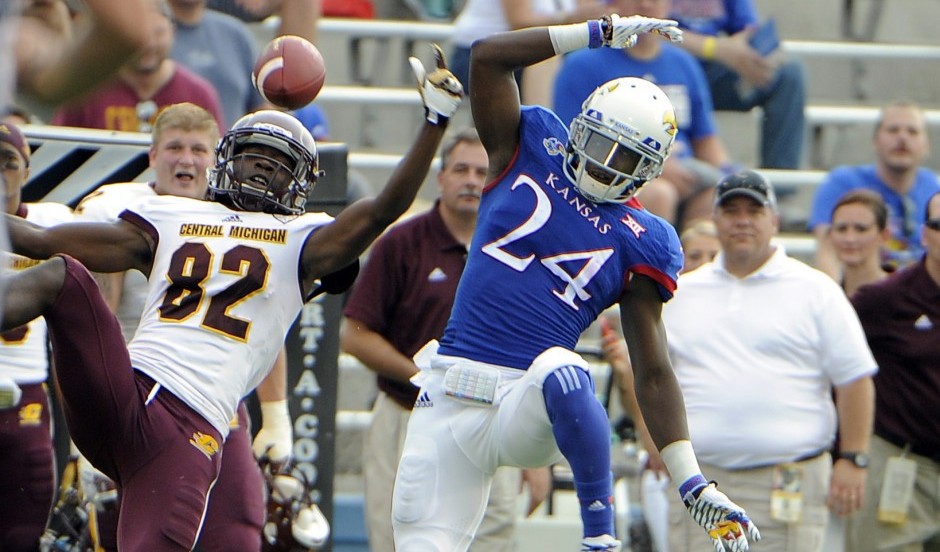No-22: What the Eagles Have In Shepherd
If JaCorey Shepherd had it to do over, he wouldn’t have run.
The sixth-round pick from Kansas sat out drills at the combine because of a hamstring injury. But when his Pro Day arrived, Shepherd felt like he had to show scouts, coaches and GMs that he had the speed to play cornerback at a high level in the NFL. So he gave it a go.
The results were not pretty. The hamstring was bothering Shepherd, and he ran a 4.65 and a 4.62 in the 40-yard dash. For a team like the Eagles that values measurables, those are not times that fit the prototype.
But Chip Kelly and his staff did their homework and decided that Shepherd played faster than the time indicated. They felt like it was pretty clear his hamstring was a factor and decided Shepherd’s upside warranted a pick.
“I definitely use the round I got picked in as motivation,” Shepherd said last week. “But like I said from the beginning, that never really mattered to me. I just wanted the opportunity. Being labeled as a slower corner, I know that’s not me, especially when you watch tape. Playing in the Big 12 conference, there weren’t too many times that I got a deep ball completed on me. So that definitely does motivate me going forward to show that ain’t the type of player that I am – 4.6 is not [me].”
Shepherd’s college career was anything but smooth. He started his career as a wide receiver before transitioning corner as a sophomore when the team needed help in the secondary.
During Shepherd’s four-year career, the Jayhawks went 9-39 and never won more than three games in a season.
Asked if it was difficult for guys on the team not to quit, Shepherd said: “It’s definitely tough. Not for me, but it’s tough for other guys. I’m a competitor. I don’t like to lose. So yeah if we lose the overall game, but I’m not gonna lose against the guy that’s lined up against me. Regardless, that’s how I play. I don’t care what the score is. I don’t care if I’m going against a first-string or a fourth-string because the score’s ran up on us. But the guy across from me is not gonna beat me. And that’s how I play.”
Shepherd (5-11, 199) has the requisite size the Eagles want out of their cornerbacks, and he played plenty of press while in college. Watching Shepherd, one skill stands out above all others: his ability to make plays on the ball.
Here’s an example against Iowa State where Shepherd plays the fade, gets his head around, finds the ball and breaks up the pass.
This next example was a free play for the offense because a defender jumped offsides, but again, Shepherd plays the fade and breaks up the pass.
He credits those ball skills to his background as a receiver.
“That’s definitely helped me, especially making the transition as quick as I did, especially playing the deep ball,” he said. “Knowing how to find the ball when it’s in the air and just reading routes, reading stems coming off. That’s one of the reasons why I do like to press because when I’m up there in press, once I turn and open, I kind of feel like I can turn back into the receiver and find the ball.”
Shepherd is very good against the fade. He’s 5-11 but shows the ability to battle bigger receivers. Here’s an example in the end zone against TCU.
Same play from another angle:
When Shepherd is in the right position, and the ball is thrown his way, he usually wins. Here’s one more example against Iowa State:
So, where are the issues? When asked to change direction quickly, particularly on in-breaking routes, Shepherd sometimes gets beaten.
Here’s an example where he gives up the reception and then can’t make the tackle.
Overall, his tackling needs work. Here, Shepherd fails to finish on a run play and gives up a huge gain.
In terms of fit, Shepherd plays more like an outside corner than a slot guy or a safety. He has the ball skills to play safety, but isn’t the biggest defensive back, and as mentioned above, tackling is not his strength.
He returned kickoffs in college, but averaged just 20.89 yards per attempt, which ranked 87th. In other words, I think Shepherd can handle those duties in a pinch, but I wouldn’t expect to see him back there consistently.
The guess here is that the coaches will continue to have him focus on his technique as an outside press corner. Shepherd is considered a high-character prospect, and he clearly does not lack confidence.
He said he feels like he could have made it to the NFL as a receiver, and when asked if he still tries to press when matched up against burners, he added: “Most definitely. I don’t care what he runs. He can run a 4.1 for all I care. I trust my speed. You can’t run if you can’t move. So if I get my hands on him, he can’t go nowhere. Or if I get my hands on him, that’s gonna disrupt his speed. So that 4.2 goes to a 4.4, 4.3. I don’t care what he is or what he runs. I’m gonna get up there and I’m challenging him. …That’s my approach. You can’t play corner if you don’t have that approach.”
It’s tough to project an immediate role for Shepherd because so much depends on how he develops in the coming months. But looking at his skill set, it’s clear to see why the Eagles took a flier on him in the sixth round.
